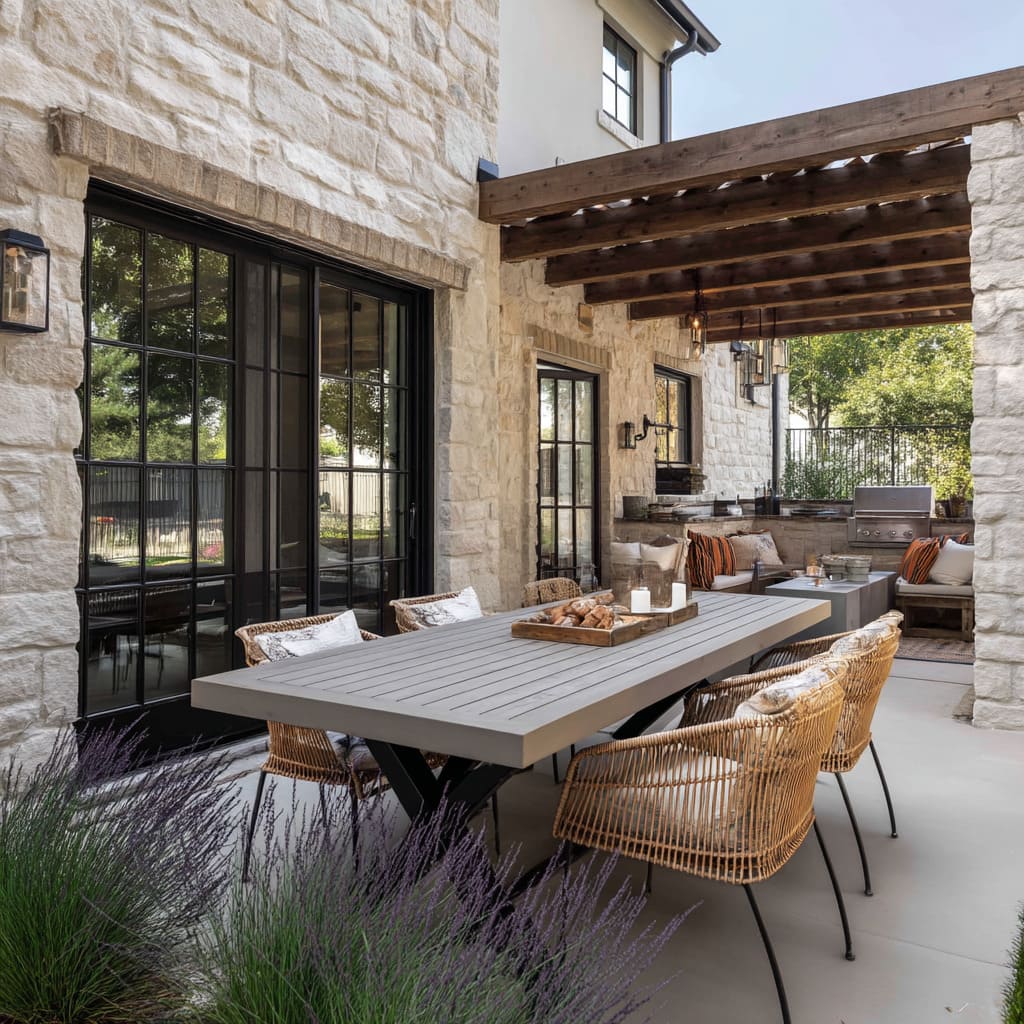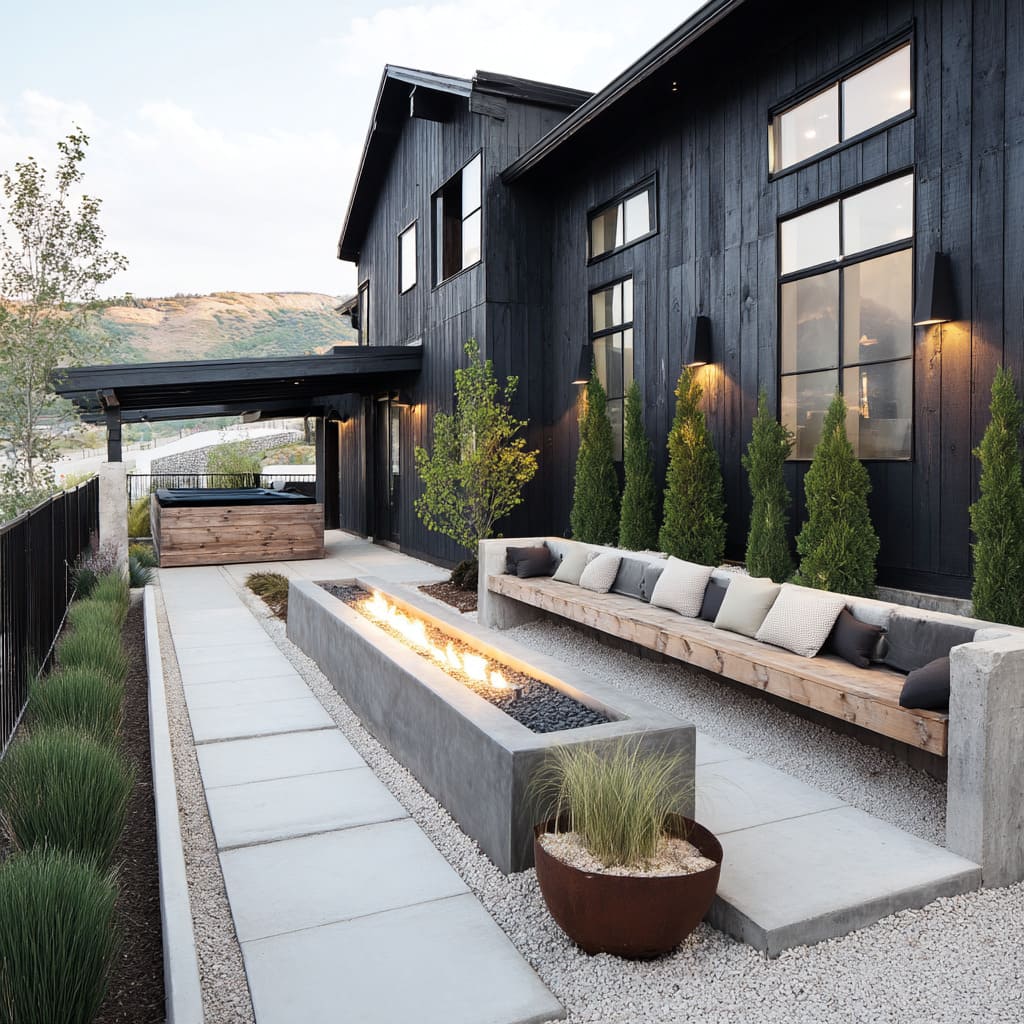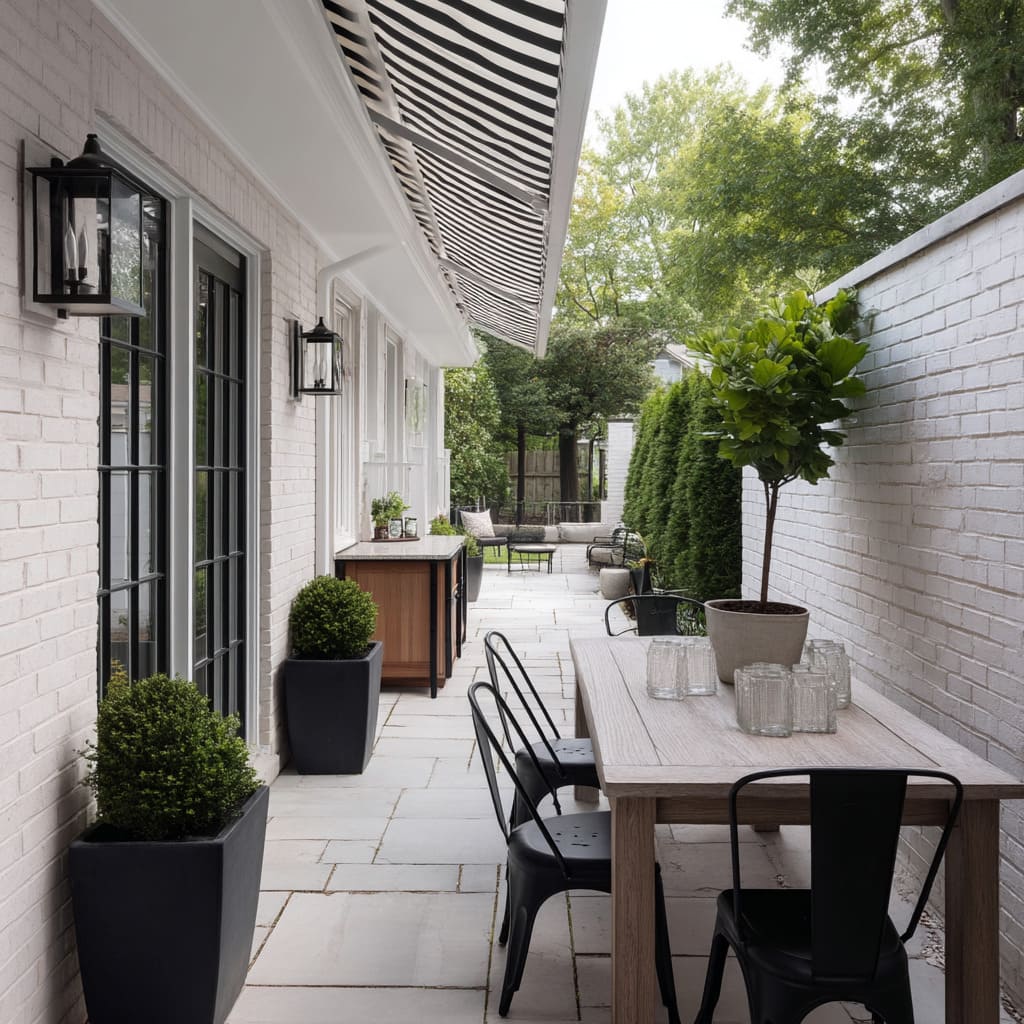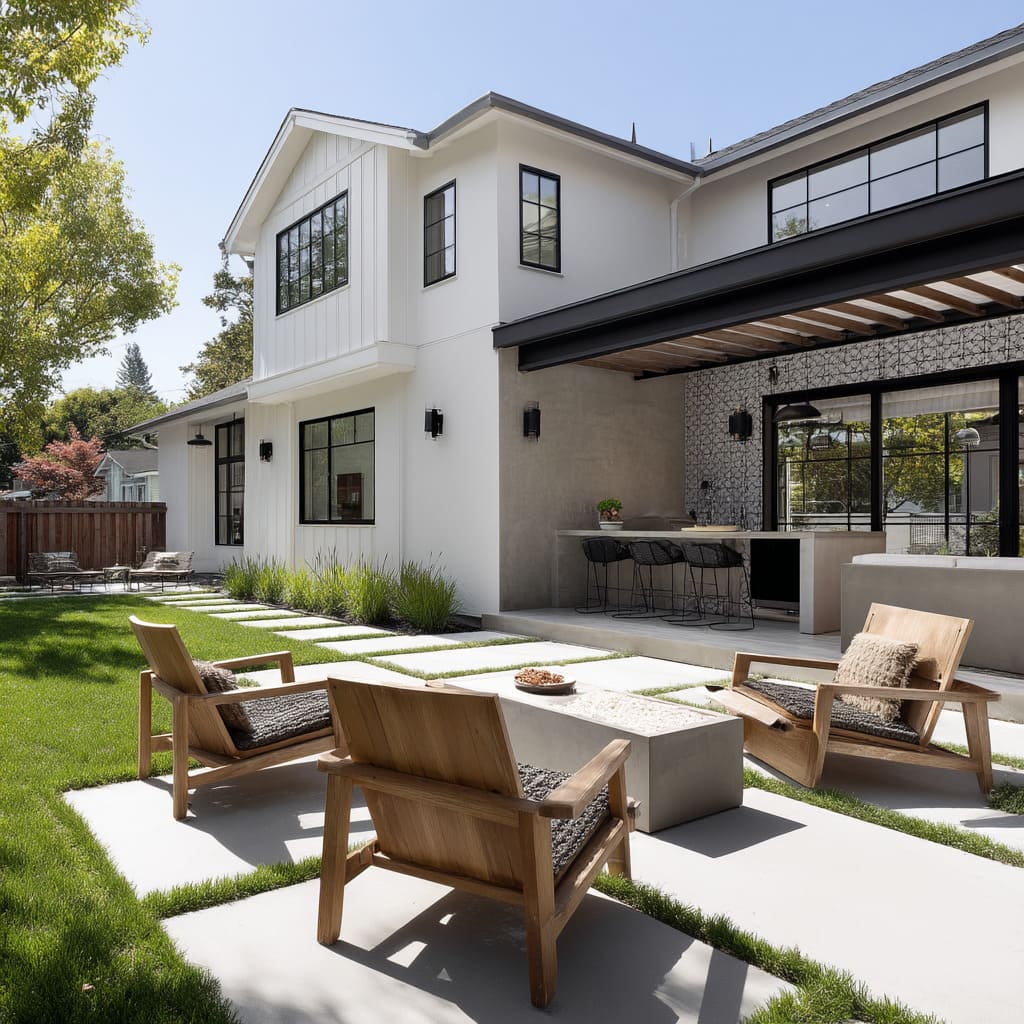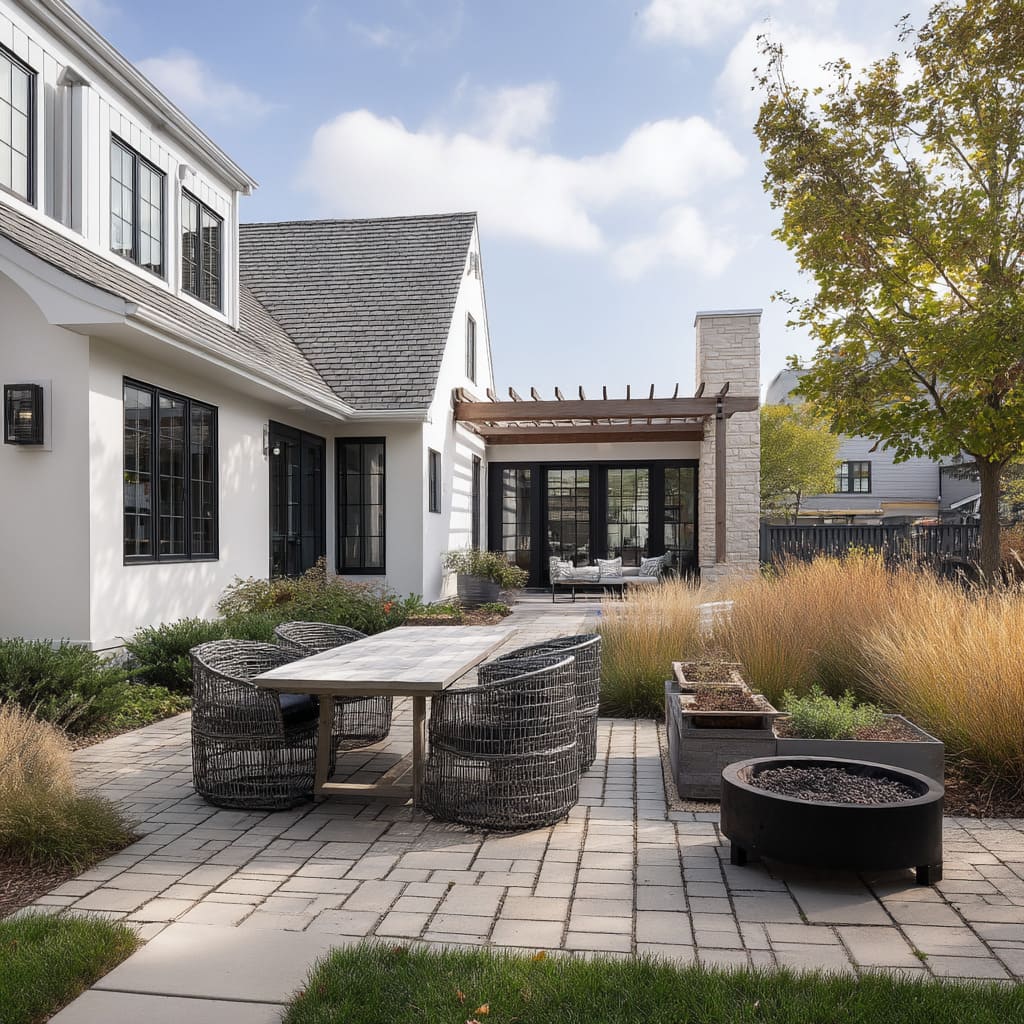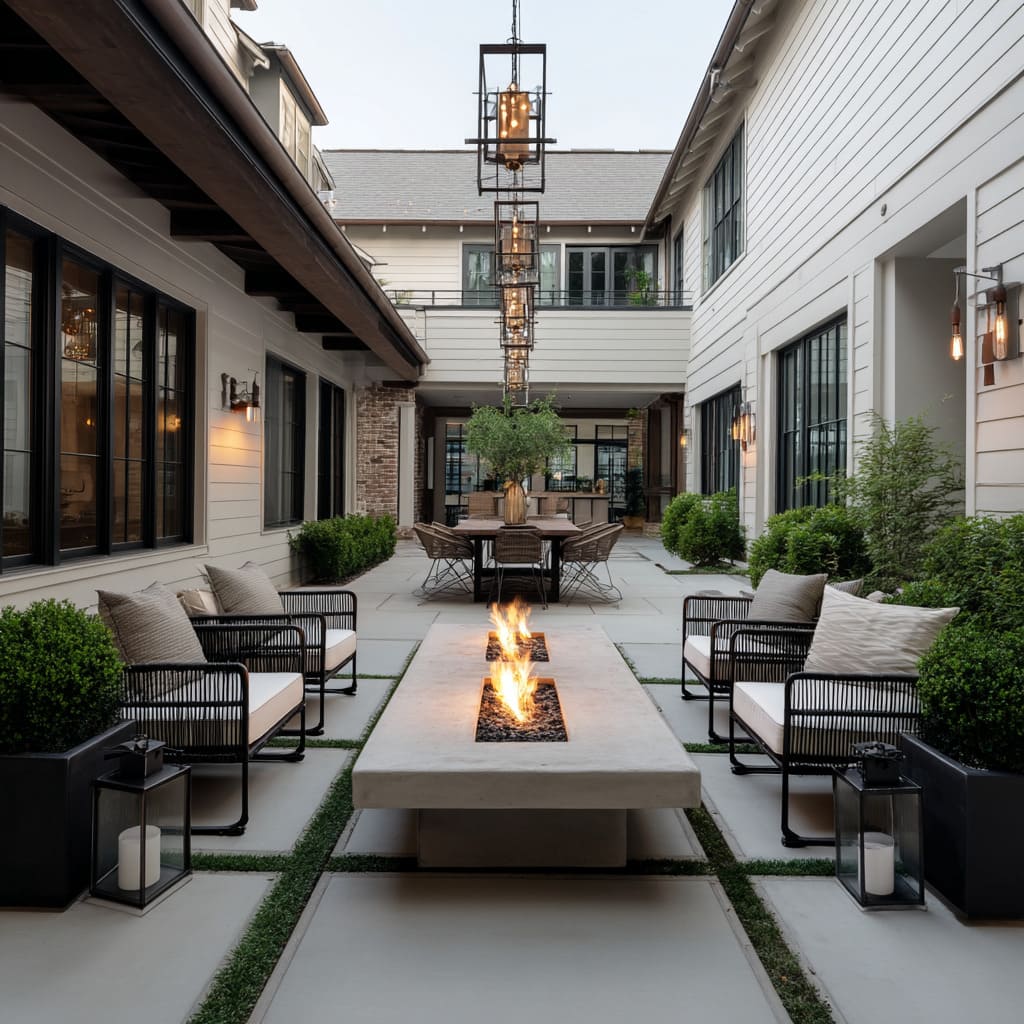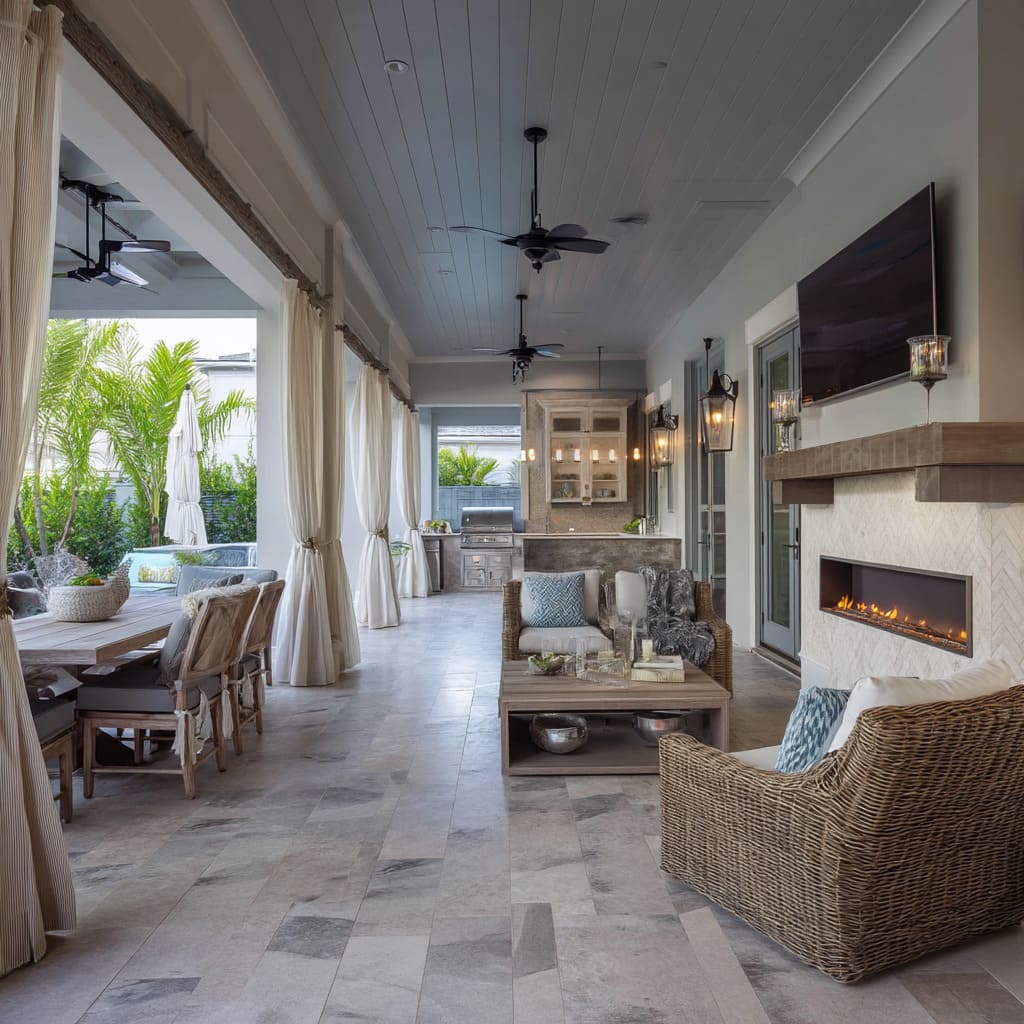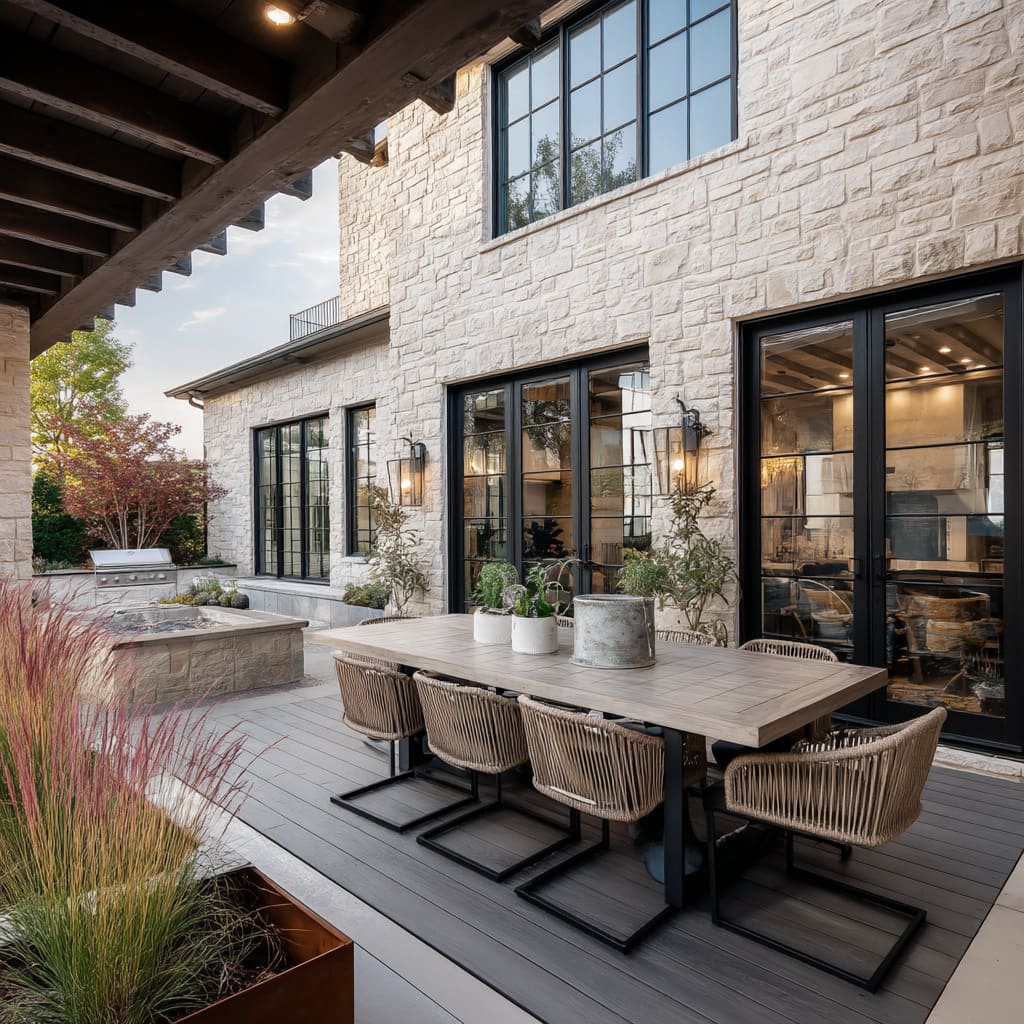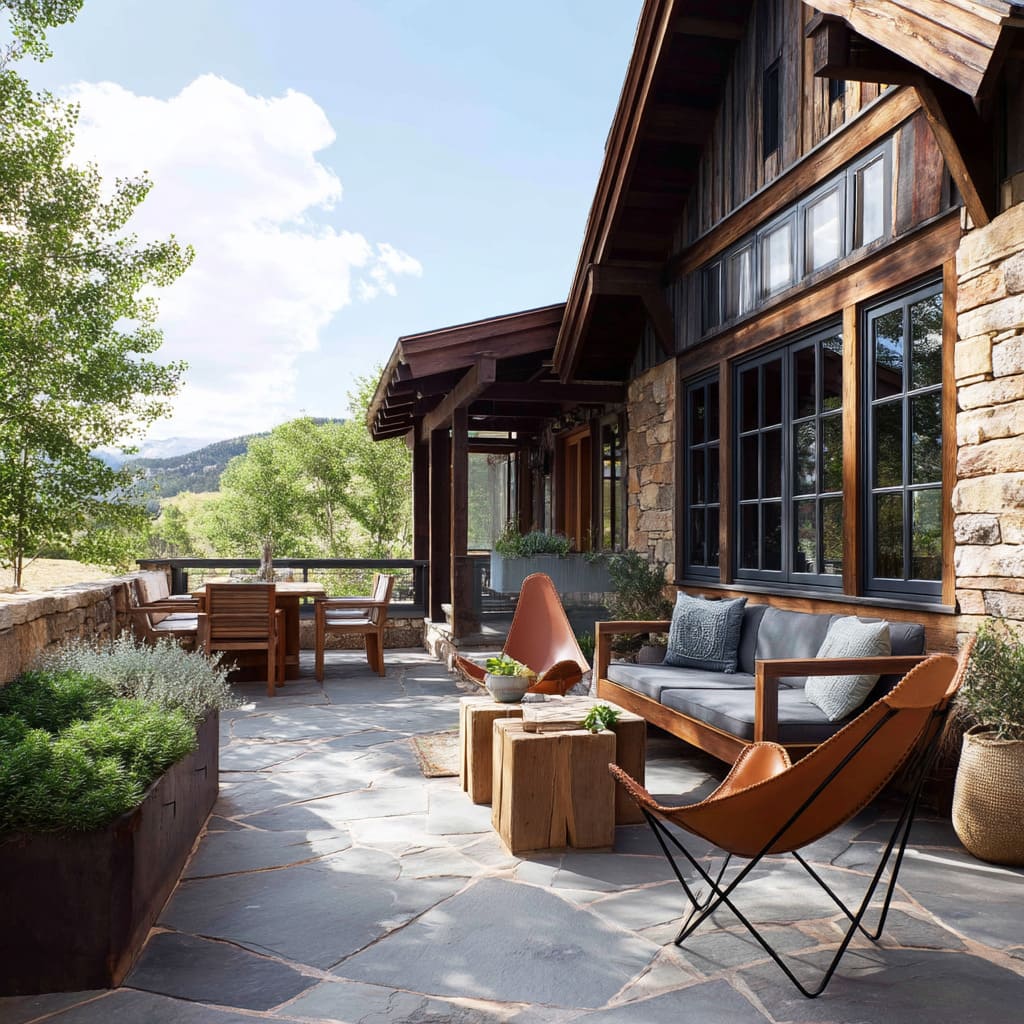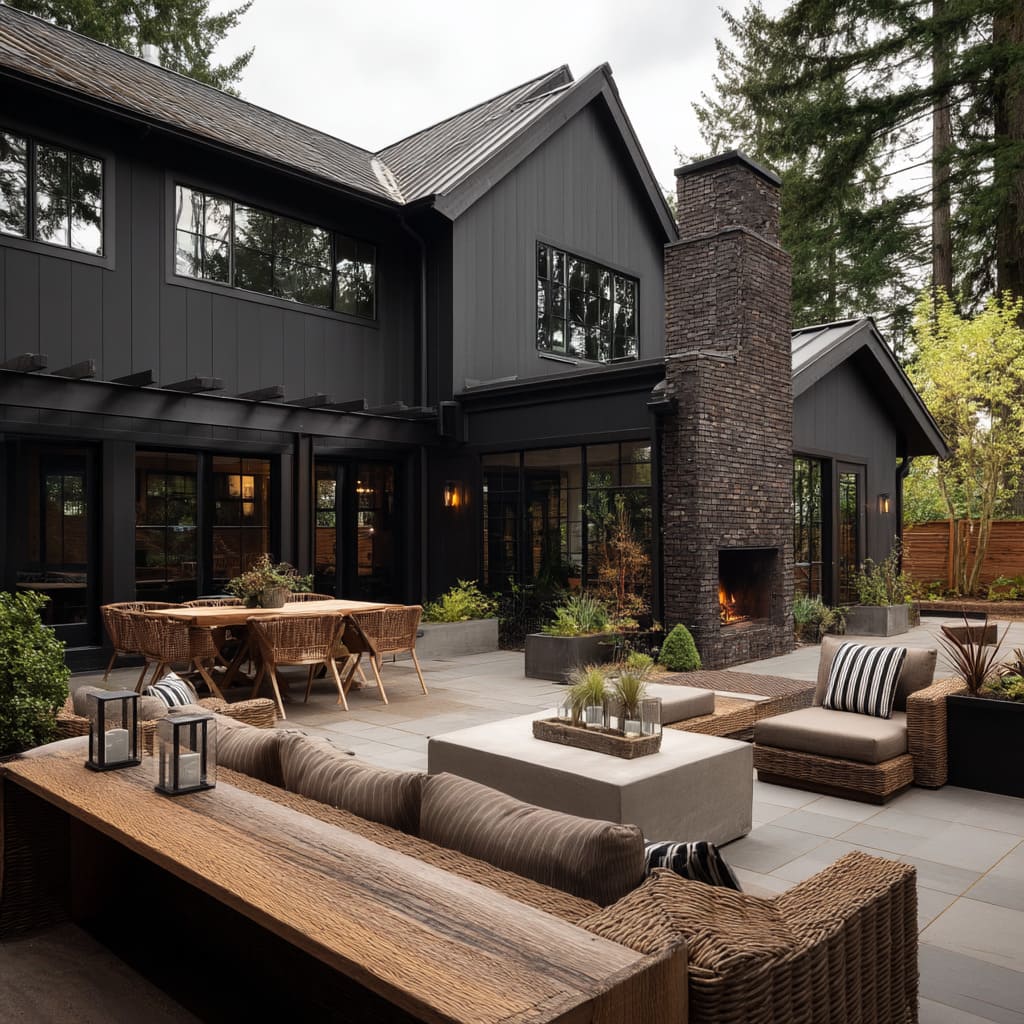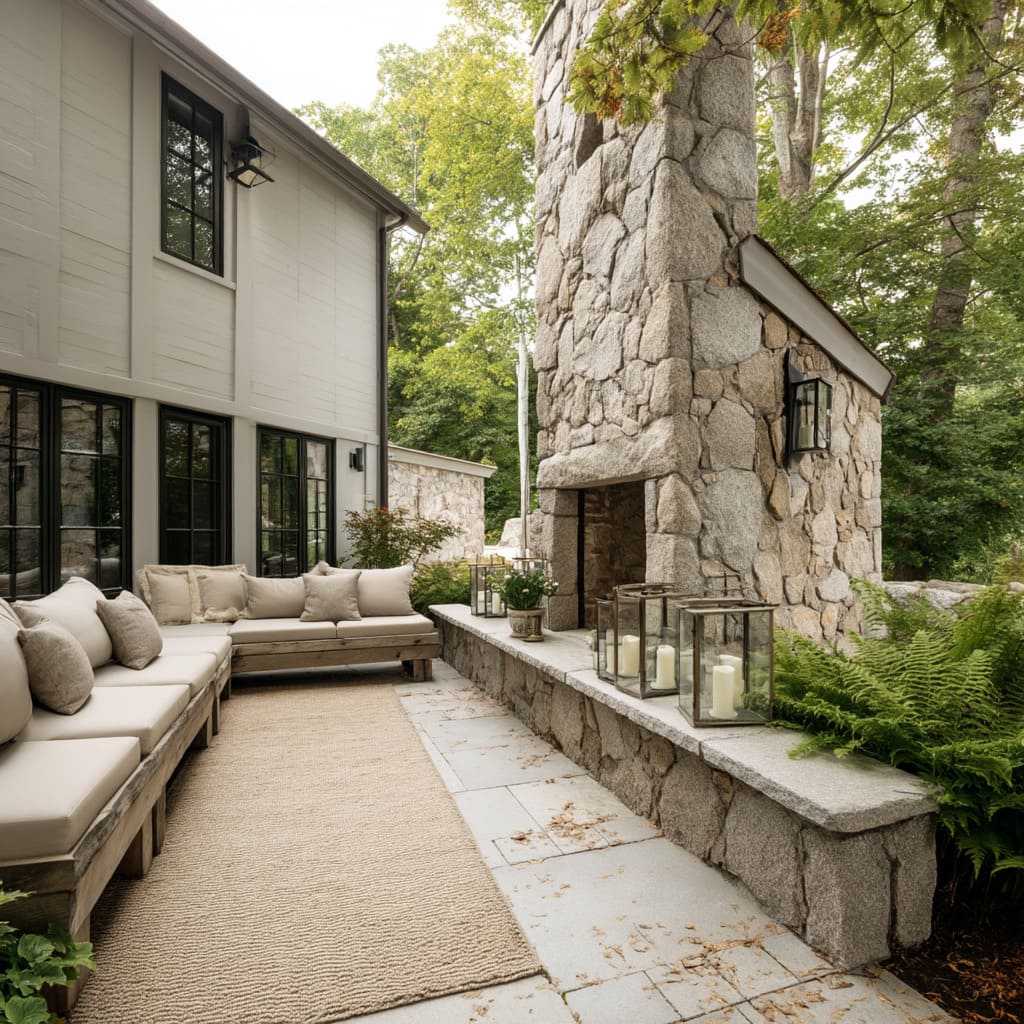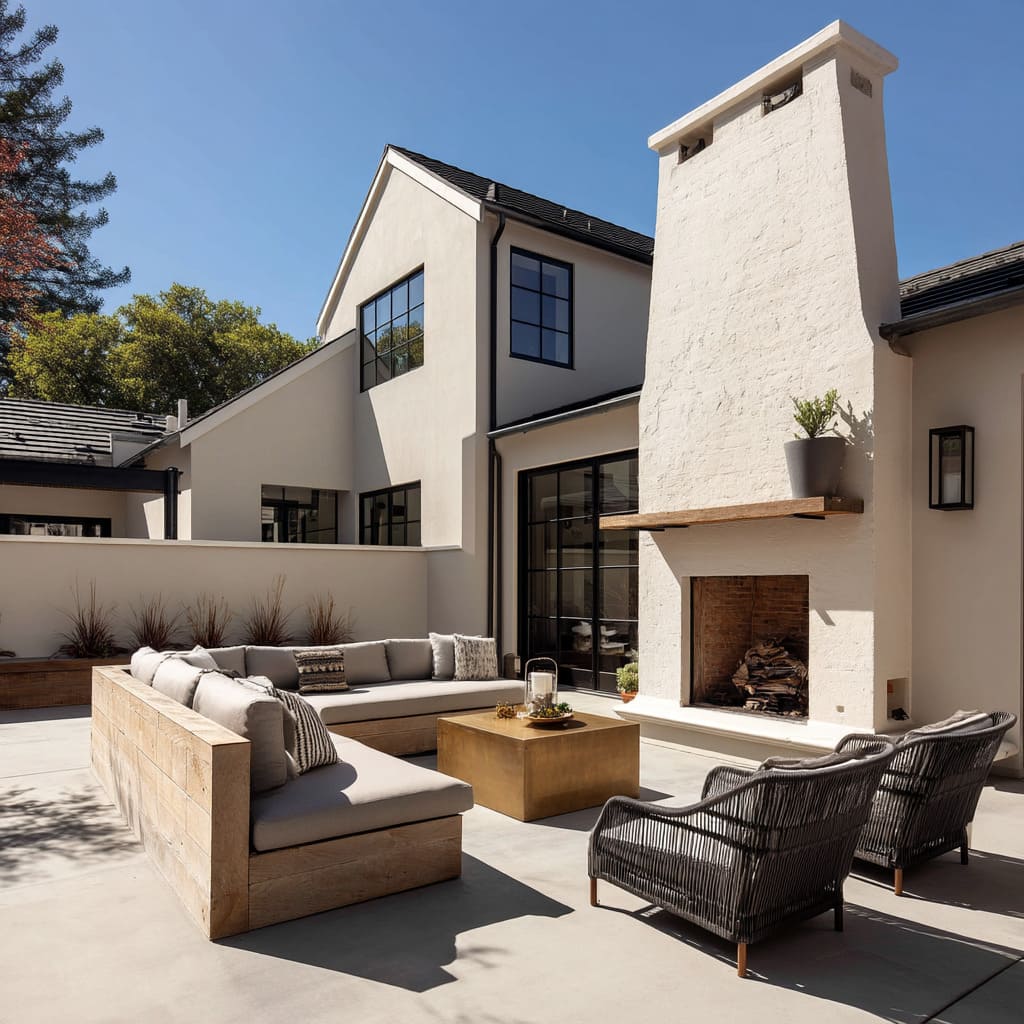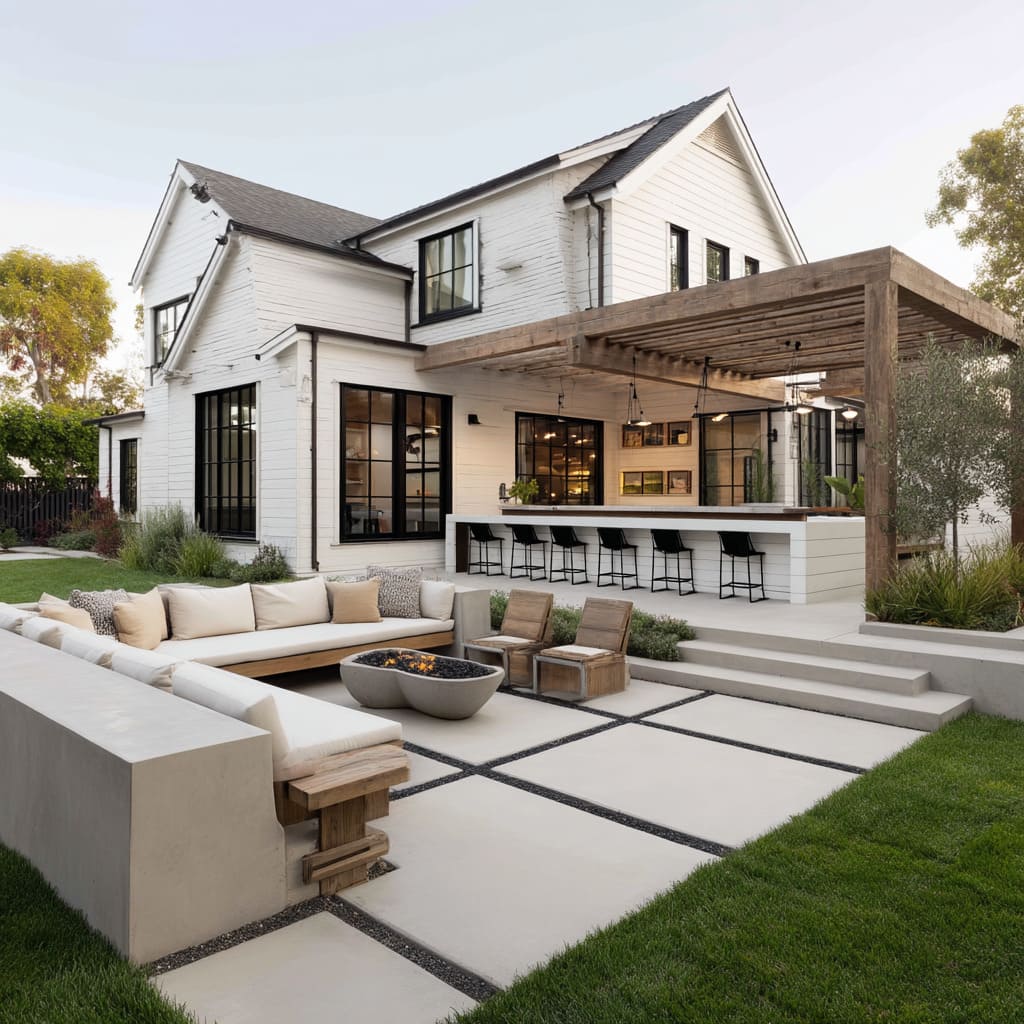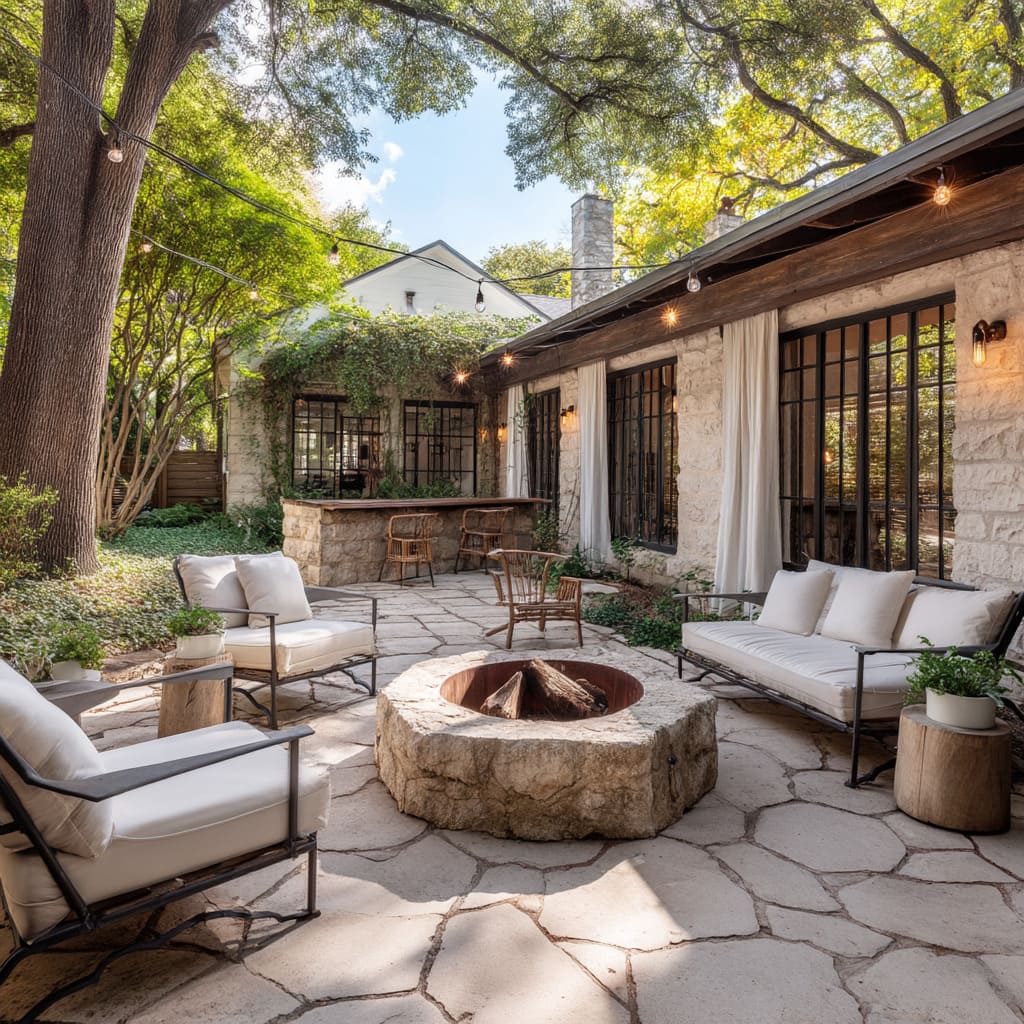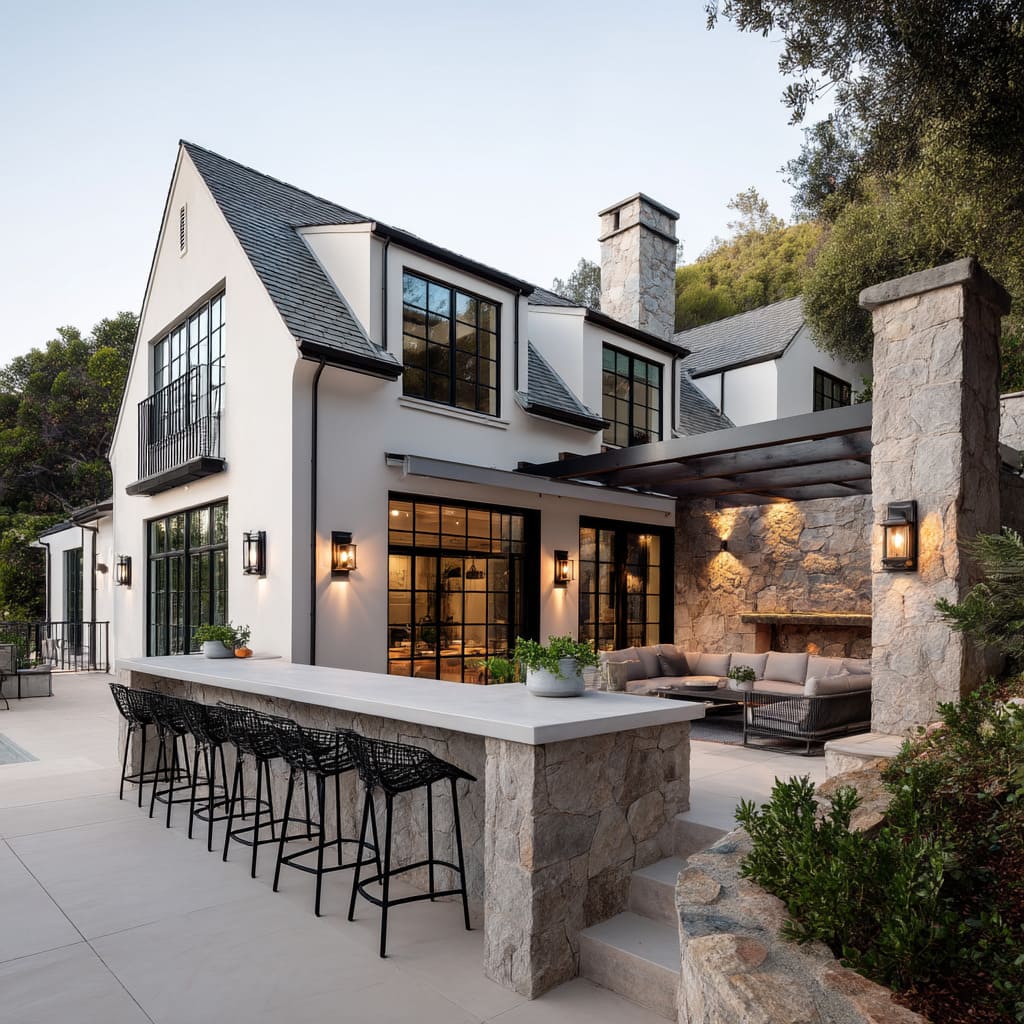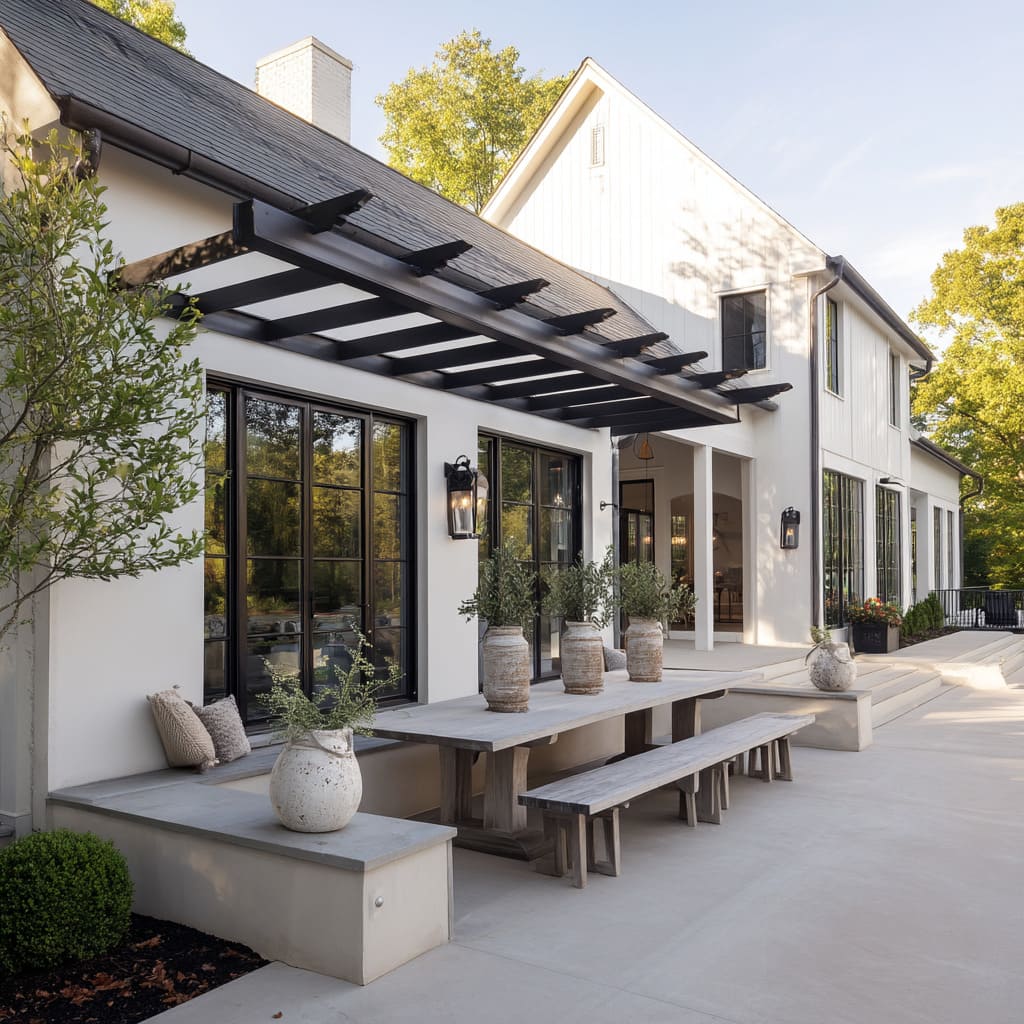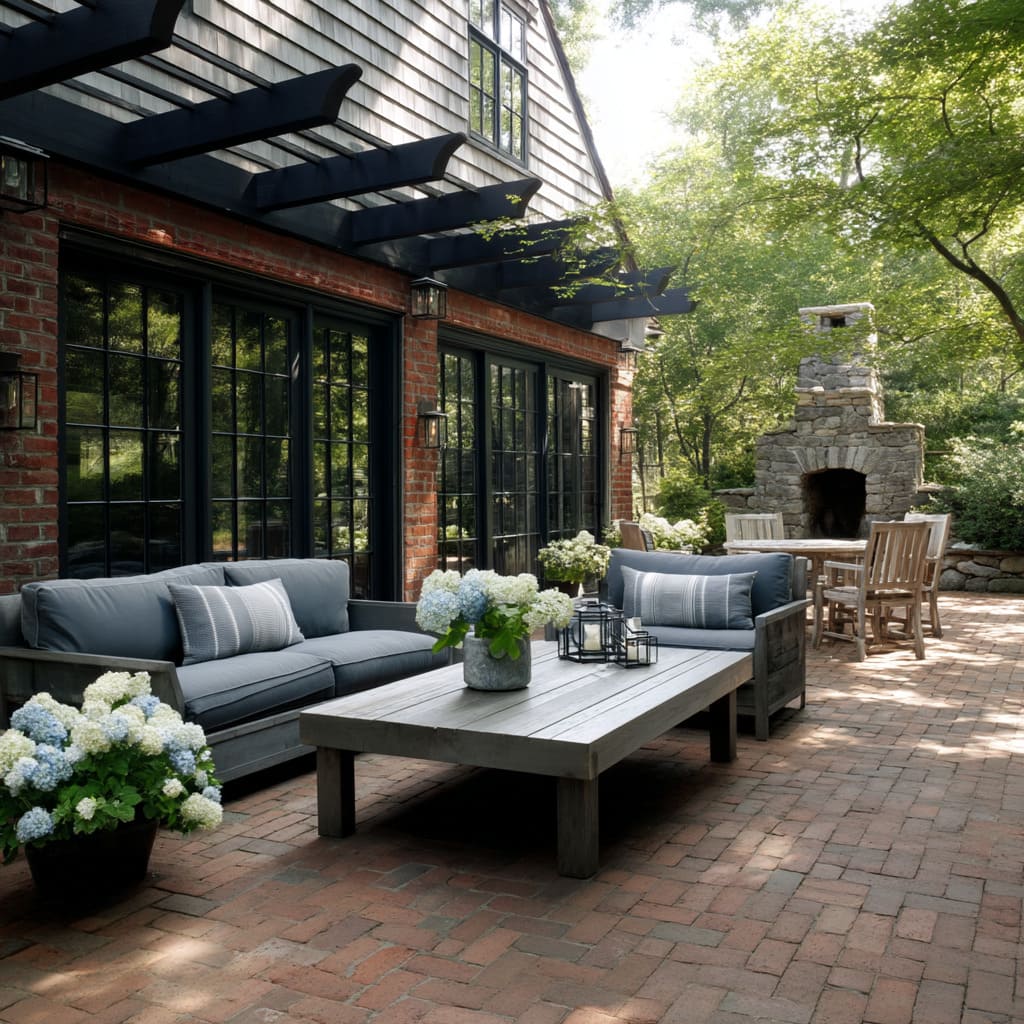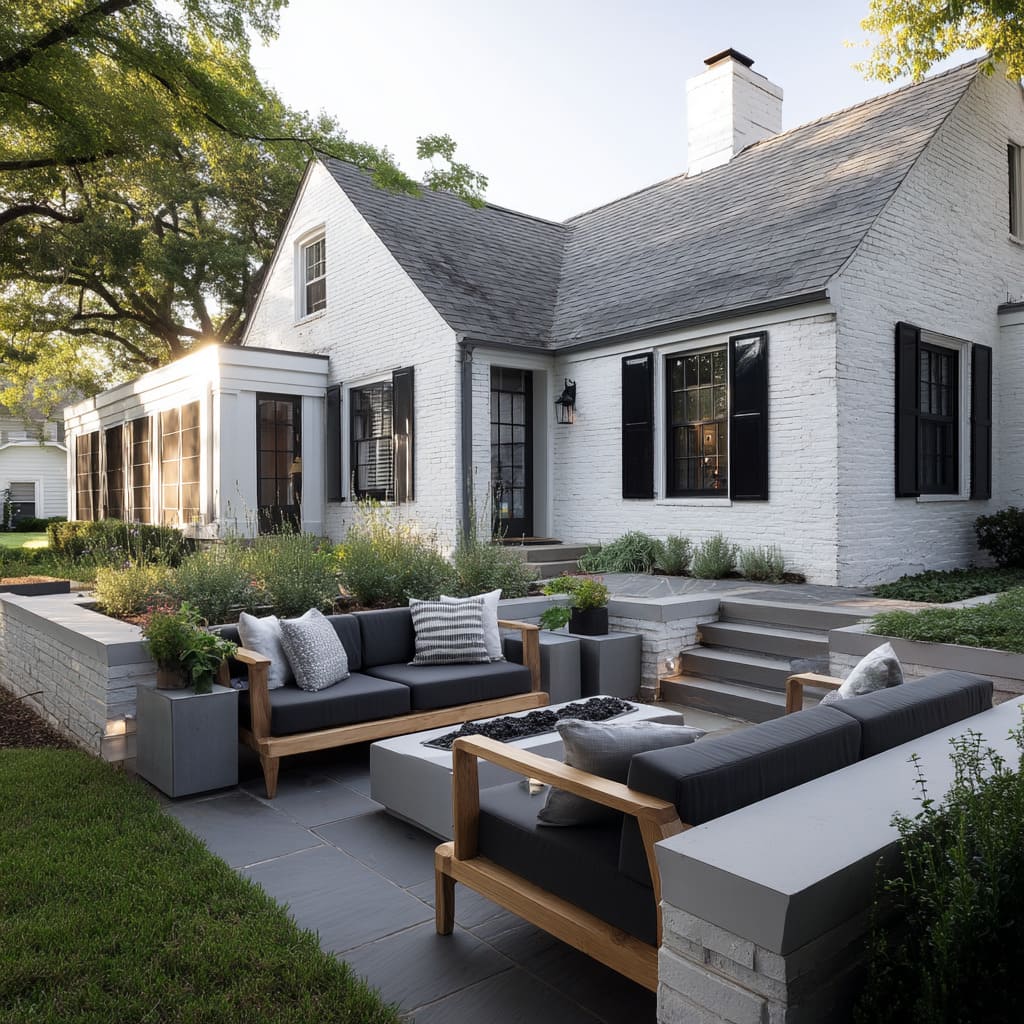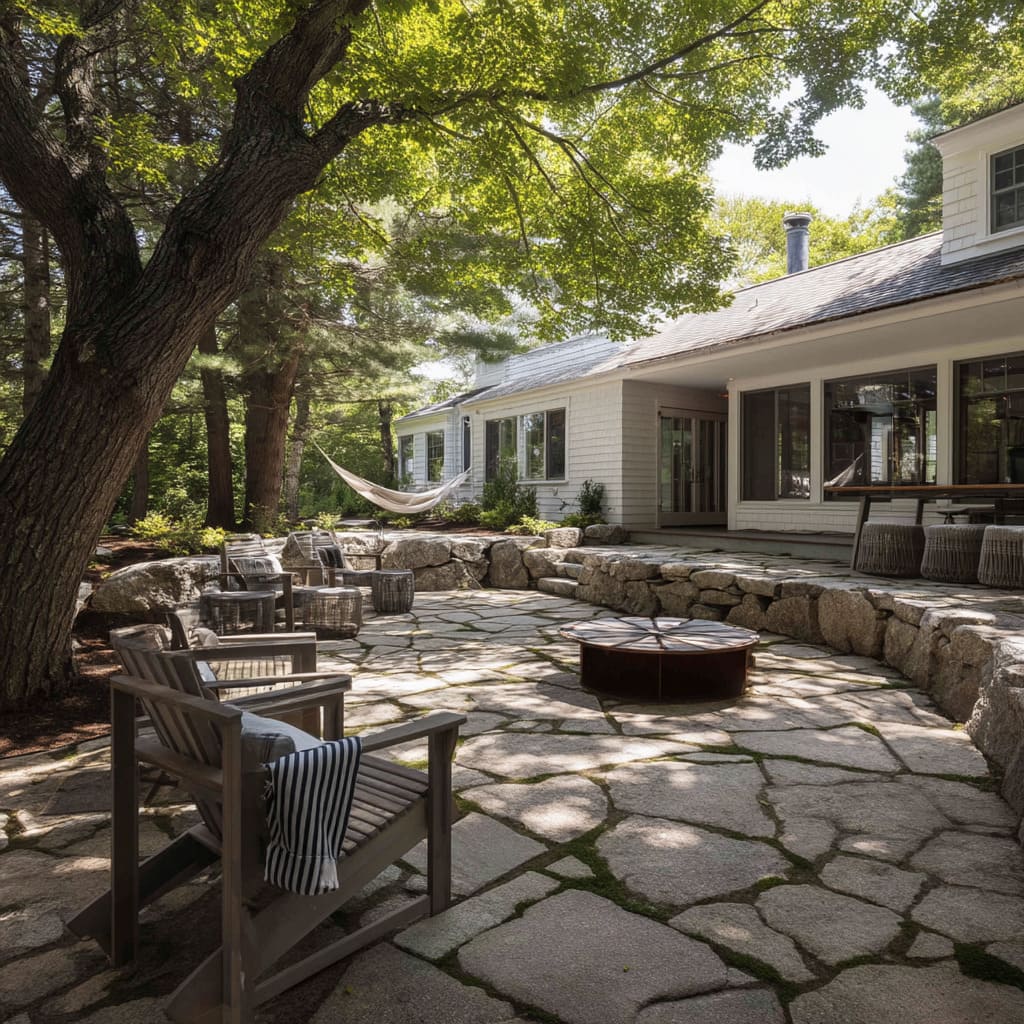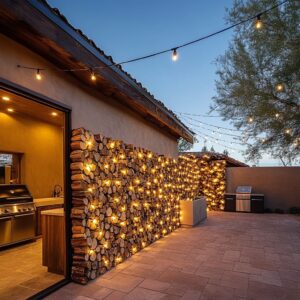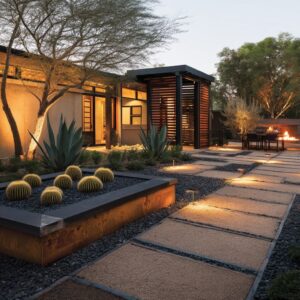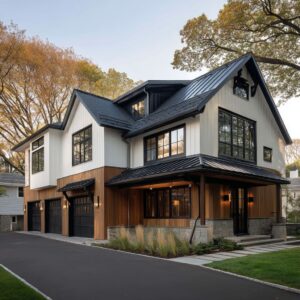The modern farmhouse patio has taken a quieter turn in recent years—away from themed decor and toward something more structured, more restrained, and closely tied to the materials themselves. Across high-end homes in various American regions, designers are building outdoor spaces that feel less like extensions of the house and more like open-air rooms with a deliberate sense of arrangement.
The elements stay low, the colors stay close to the ground, and everything seems built to settle in rather than stand out.
What’s common across farmhouse patio ideas isn’t a single material or layout, but a shared attention to proportion, texture, and how one feature blends into the next. Patios are no longer laid out in rigid rectangles but shaped by micro shifts in elevation, light breaks between boards, or the grain direction of wood.
Seating dips into the ground by a few inches to block wind. Dining areas run flush with interior flooring to extend the indoor grid.
Even plant choices—like repeated lavender rows or upright grasses—feel tuned to match the hardscape lines instead of softening them randomly. Material choices speak quietly but with confidence.
You’ll find stone used as both surface and support, brick pulled from historic patterns but finished in subtle monochromes, and concrete applied across surfaces with different textures instead of different tones. Instead of layering finishes, the design intent comes through repetition and alignment—across stairs, walls, benches, and furniture frames.
Even lighting follows this approach. Lanterns are placed at sitting height.
Benches are underlit. Fire pits are long and low, aligned with the shape of the yard instead of centered for symmetry.
Every move builds on the last, and the final result feels more composed than decorated.
From wooded yards ito slim terraces, the new direction in outdoor layout leans into structure, not ornament. It’s this built-in simplicity that holds attention longest.
The spaces don’t compete with their surroundings—they fold into them, piece by piece. This article explores how that can be done through layout, material, planting, and subtle detailing, using standout farmhouse patio ideas that balance precision with quiet character.
Spatial Coding: Levels, Lines, and Lenses
One of the key moves that keeps modern farmhouse patio ideas sharp and space-savvy is how the outdoor layout shifts vertically and visually—without breaking its calm rhythm. It starts with lowering the lounge.
Designers are using sunken seating areas that drop by 8 to 12 inches, which changes more than just the view. That dip cuts down on wind exposure in open yards, while letting dining zones stay level with the main floor inside.
This subtle difference separates relaxation from mealtime without adding walls or fences.
In tighter footprints, like side yards or slim courtyards, wide circular fire pits are giving way to narrow fire channels. These fire strips are often no more than 16 inches wide and are usually paired with long benches running right alongside them.
That one switch flattens the visual layout. Instead of reading the space as a tight corridor, your eye runs with the lines, doubling the feel of the width.
This technique is especially common in high-end farm style patio ideas in the West, where space between homes can be slim but privacy still matters.
Another layered detail is how designers line up indoor and outdoor elements through framed openings. By placing black-trim glass doors directly behind outdoor dining tables and matching them with pendant lights inside and lanterns outside, they create what feels like a clean visual tunnel.
The dining setup doesn’t stand alone—it becomes a continuation of the kitchen or living space behind it. That pull-through effect doesn’t just lengthen the view; it connects the house and yard in a quiet way, without any big statements or changes in material.
Planting Intelligence
Some of the most effective farm-style layouts are anchored not by their structures but by what’s planted around them—and how those plantings are repeated just enough to feel intentional. Lavender, in particular, keeps showing up not as a floral highlight but as a structural element.
Its muted gray-green foliage blends seamlessly with stone pavers, concrete edges, and deep charcoal accents, while its scent and drought tolerance make it a favorite along patio borders in Western and Southern climates. It’s a small touch that supports the whole layout.
Instead of rigid shrubs, many designers now rely on ornamental grasses—especially in patio corners or where built-in seating ends. These grasses don’t form solid walls; they sway with the wind and break the hard lines of board-and-batten siding or blocky concrete.
This movement adds life and variation across seasons, especially when other materials stay fixed and quiet.
And while vegetable gardens used to live in separate patches, modern farmhouse patio ideas often bring edibles right into view. Raised beds or low troughs placed near lounge areas now grow herbs and seasonal greens, housed in boxes that align cleanly with the paving pattern.
The layout stays crisp, the function is real, and the message is clear: this is not just a show garden—it’s part of how the outdoor space is used. One small trick is keeping soil lines two inches below the level of the stone or concrete.
That simple offset avoids mulch spill during rain and keeps the edges looking fresh without constant cleanup. It’s the kind of small move that keeps a yard polished through both summer sun and stormy weeks, showing how much control lies in the smallest construction lines.
Palette & Finish
Across many of the most thoughtful modern farmhouse patio ideas, what stands out isn’t how much color is used, but how deliberately it’s limited. The base palette rarely strays beyond three core neutrals: soft charcoal, driftwood gray, and warm white.
These tones work well with wood beams, stone paving, and surrounding foliage, keeping the overall view grounded and balanced. They don’t compete for attention but support everything else layered over them—textures, lighting, and plant life.
Accent metals are always matte and grounded in a sense of permanence. Flat black comes in through door trims, lantern cages, and fire pit edges, while aged bronze adds a quieter depth on planter legs, sconces, and wall hooks.
You won’t see polished chrome or glossy stainless finishes in these setups; their shine feels too sharp against the natural texture of flagstone and wood grain. Soft goods carry the most nuance, especially when seen in seating.
Taupe and clay tones are used in cushions and pillows, sometimes layered with muted blue-gray for added softness. But the trick is in the details—patterns aren’t bold or decorative.
They show up in tiny ways: a pinstripe, a small-scale check, a subtle basket weave. These aren’t there to draw the eye, but to bring in touchable texture that makes the space feel grounded.
Every now and then, a single contrasting piece steps into view. A rusted steel planter tucked in a corner or a low brass coffee table catching the light.
These pieces act like punctuation marks—rare and deliberate. In farm style patio ideas especially, this contrast between the aged and the minimal makes the space feel settled rather than new, lived-in rather than staged.
Seating Archetypes & Texture Strategy
| Cluster | Key Traits | Hidden Insight |
|---|---|---|
| Wide-plank sectionals | Raw wood boxes + oversize box cushions | Oversize cushions hide winter storage bins built into the frames—smart small-yard storage |
| Butterfly chairs revival | Metal-rod frame + sling leather | The thin legs minimize stone contact, reducing freeze-thaw rust marks in alpine climates |
| Rope-wrapped forms | Marine rope on steel | Rope is self-draining; its shadows add pattern in an otherwise tone-on-tone palette |
| Built-in benches | Masonry base + loose cushions | Under-seat LED strips amplify seat depth at night while doubling as pathway lighting |
Worthy Design Ideas
Some of the most effective backyard ideas aren’t the ones that dominate the scene—they’re the ones that slip in unnoticed but carry the whole composition. Like grass ribbons between concrete pavers.
That 4-inch band of green softens the layout and adds visual rhythm, almost like stitching across a quilt. It costs less than a patterned paver but adds more structure to the eye.
Other ideas use light in ways that skip overhead glare. Take the move of placing lanterns directly on the stone hearth.
The flame reflects off the rough surface, casting flickering shadows that feel closer to firelight from a campsite than an outdoor spotlight. This trick pulls attention down, not up, which makes open-air spaces feel more intimate.
On the seating side, the tactile choices matter. A smooth concrete bench might sound cold—until a reclaimed wood slat is inset right at the backrest line.
It’s a narrow detail, but one that shifts the feeling of the whole piece. The warmth of that wood against the cool of the concrete adds just enough depth to suggest connection with the house interior, especially when the flooring carries a similar tone or grain.
There’s also a quiet choreography between inside and out. Like when outdoor rope chairs are shaped with the same cantilevered silhouette as the stools by the indoor bar.
That shared line draws the spaces together visually—even if no one notices right away.
Some of the most thoughtful moves aren’t visual at all. Like building a low bench with hollow skirting, then cutting in vents to hold pillows.
It keeps cushions dry and out of sight, but ready for quick use. No separate storage bin needed, no trail of clutter when the rain comes.
This kind of dual-purpose form—structure that quietly carries function—is showing up more often in modern farmhouse patio ideas where space and simplicity are both valued.
These aren’t show-off moves. They’re the kind of ideas that hold the patio together, even if no one talks about them.
And that’s what gives these spaces their weight—nothing is louder than it needs to be, but everything serves a reason.
Lighting Language
| Technique | Why It Works | |
|---|---|---|
| 1 | Lantern clusters at mixed heights | Adds vertical punctuation in wide courtyards without adding more furniture |
| 2 | Under-seat or under-bench strip glow | Marks edges in big patios and doubles as night guide without pole lights |
| 3 | Fairy-light canopies | The droop lines visually lower tall trees and give ceiling effect outdoors |
Putting It All Together
The most forward-looking farmhouse outdoor patio ideas carry the quiet clarity of a space that doesn’t try to impress all at once. These patios work because they’re built like indoor rooms—only with light, shadow, and sky as their fourth wall.
What’s common is how everything feels connected, from ground to planter edge, without the look of parts being added one by one. It begins with material continuity.
Whether it’s fieldstone, brick, or poured concrete, the surface that forms the patio floor should be the same one that steps up into a bench, wraps a raised planter, or climbs into low retaining walls. Using a single masonry tone—like creamy limestone or aged red brick—and repeating it across horizontal and vertical surfaces ties the whole space together.
This creates a calm visual rhythm and removes the stop-start feeling that mismatched patios often carry.
Levels are then used to subtly guide how the space is read. A recessed lounge dug 11 inches lower than the dining terrace does more than just add variation.
It frames that sitting area like a pocket, giving it shelter from wind and sun, while also helping manage surface runoff in wetter climates. Meanwhile, even a 4-inch rise in a planter edge can double as a perch for casual seating or child-height gardening.
These micro-level shifts help divide space without physical barriers.
Instead of loading the scene with decorative items, the depth comes from how the materials play with light. Narrow vertical slats in benches or fences, twisted rope details on lounge chairs, and the shadows cast from slender metal pergolas all provide visual texture without adding bulk.
Where color exists, it stays quiet—bone white, clay brown, faded slate. Then movement is added through plants: ornamental grasses and spiky herbs that shift in the breeze and fill gaps between the structure and the sky.
Tactility is woven in sparingly, but with purpose. Lavender borders bring both scent and a subtle gray tone that matches weathered wood or stone.
A rusted steel box tucked in the corner doesn’t scream for attention, but its surface texture draws the hand. A compact brass table placed between neutral cushions may pick up the sunset for just a moment—but that moment is enough to anchor the composition.
Once night falls, the entire mood changes with how lighting is handled. Rather than relying on overhead fixtures, the scene is built from below.
Thin strips of warm LEDs under floating benches or behind planter lips gently wash the ground. Lanterns placed on stone ledges or table tops flicker without glare.
The glow stays low, no higher than eye level, which keeps the space feeling like a private gathering rather than a stage.
The common thread in all of this is restraint. The most refined layouts aren’t minimal for the sake of style, but because they rely on structure, finish, and proportion to do the work.
The best of today’s American designers are tuning farmhouse outdoor patio ideas to match the way people really live: with a rhythm that’s slow, grounded, and easy to stay in longer than planned. Nothing shouts, but everything matters.
